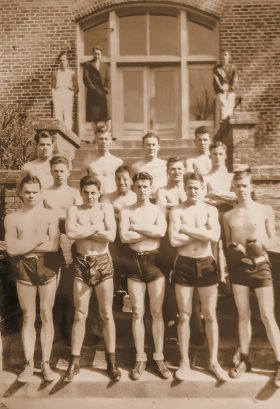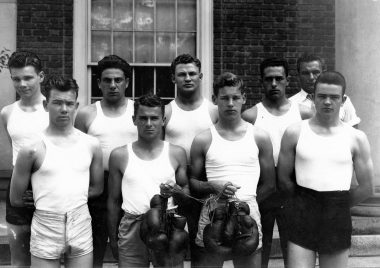Boxing gloves used to be a popular accessory for Elon students in the 1930s and 1940s.

There was a time when it was common for college athletes who were looking to develop speed and quick thinking and build self-confidence to turn to boxing as an addition to any team sport they played. Elon athletes were no exception.
It’s not clear when exactly the sport started to take hold at Elon, but the first reference to boxing found in the university archives appears in the 1921–22 Bulletin of Elon College, as part of an advanced gym course offered by the Department of Physical Culture. A note in the Feb. 5, 1931, edition of the Maroon and Gold reported that a gym for boxing was near completion in the basement of North Dormitory, a three-story building that housed rooms for men. The note pointed out that many of the boxing and wrestling classes that semester were already full, which suggests there was much interest in the sport. Later that spring, a boxing exhibition was held on campus by the Boxing Club to gauge the interest of students in forming a school team.
It wasn’t until 1936 that boxing was added as a regular club sport “for the first time in the history of athletics at Elon College,” according to that year’s Phi Psi Cli, with former University of North Carolina football star Ellis Fysal serving as coach. The boxing team held three meets during its inaugural season without much success—it lost each time to Oak Ridge Military Institute, UNC and Duke University, respectively—though the writers of the yearbook remained optimistic about the team’s prospects. They had good reason to be.

The sport was blossoming but then, World War II happened, and like many other athletics programs, boxing had to be put on hold in the 1940s as men enlisted to fight. There is a mention of an unofficial team competing in a regional tournament in 1943 and an attempt to “get down to the regular grind of training” in a March 31, 1945, Maroon and Gold article, an effort that was moot after the area Golden Gloves tournament was canceled. The writer of the article went on to lament such change in fortune for a team that just years earlier had “walked off with practically every trophy that the Burlington and Greensboro Chambers of Commerce owned” and even gotten all the way to the national finals in Madison Square Garden, referring to Golombek, whose own college career was put on hold due to the war. He finally graduated in 1948.
By the early 1950s, there is only a casual mention in the Maroon and Gold that boxing wasn’t a formal sport any longer, with students interested in the sport fighting as members of local squads instead. And while the sport is no longer practiced at Elon, the memory of the program’s success lives on in the university’s archives.


